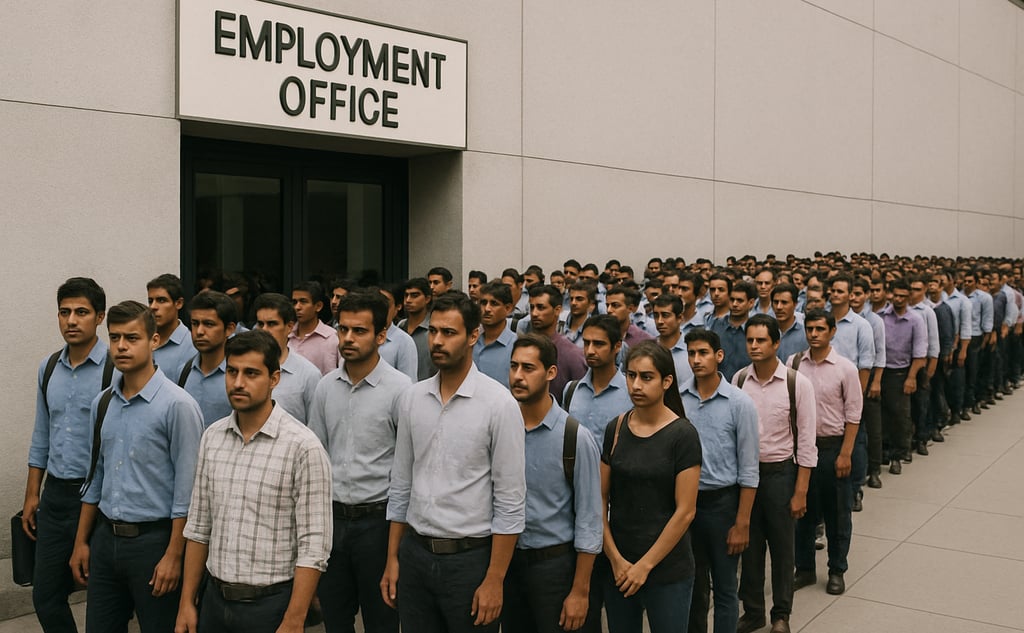Decades of Declining Jobs in India: What Went Wrong?
Explore the crisis of employment in India—decades of declining jobs, economic challenges, and shrinking opportunities that threaten the nation’s workforce."
Sonu Ahmed
9/4/20254 min read


A Nation of Aspirations but Empty Pockets
India is often described as the land of opportunities. From the bustling cities to quiet villages, people believe jobs in India should be plentiful. But reality paints a different picture. Over the last few decades, employment opportunities have declined like water leaking from a cracked pot. The dream of stable work turned into a mirage for millions of Indians.
Early Promises That Faded Away
After the 1991 economic reforms, India was promised a brighter future. Politicians claimed millions of new jobs would appear, and families placed their hopes on that dream. The IT boom in cities like Bengaluru and Hyderabad created headlines, but it was only a small boat in a sea of job seekers. Millions were left stranded. As the proverb goes, “All that glitters is not gold.”
Population Explosion vs. Job Creation
India’s population grew rapidly, and so did education. Yet, jobs in India didn’t grow at the same pace. Imagine a train with 100 seats and 500 passengers fighting to get in—that’s India’s job market. Overqualified graduates often ended up in delivery jobs or part-time gigs. The imbalance between supply and demand made unemployment a national crisis.
Decline of Manufacturing Jobs
India once relied on its factories—textiles, automobiles, and steel plants roared with activity. But automation, global competition, and outsourcing changed the game. Machines replaced humans, and employers preferred efficiency over manpower. As industries declined, thousands of workers were left behind. The so-called “Make in India” campaign looked good in advertisements but struggled in execution.
Agriculture: Still the Weak Backbone
Farming remains India’s largest source of livelihood. Yet, low productivity, small land holdings, and poor irrigation made agriculture a sinking ship. Farmers, unable to survive, migrated to cities in search of better jobs. But urban India had little to offer them. Truly, “You can’t squeeze water from a dry well.”
Education Without Employability
Degrees multiplied, but jobs didn’t. Colleges produced engineers, doctors, and MBAs, but industries complained of skill shortages. The education system focused on rote learning rather than practical knowledge. This mismatch led to educated unemployment—graduates without suitable jobs. It became a bitter joke: engineers driving cabs and MBAs working as sales clerks.
Government jobs in India are still seen as the ultimate dream. But opportunities are limited. For one vacancy, thousands apply, turning it into a lottery rather than a fair chance. Exams take years, and delays in recruitment crush the hopes of many youths. Truly, it’s not just a rat race—it’s a race with no finish line.
The Gig Economy: A Shiny Trap
Food delivery, ride-sharing, and freelancing seemed like a silver lining. But the gig economy provided crumbs instead of bread. No job security, no medical benefits, and unstable income made it unsustainable. India became a land of apps rather than a land of careers.
Every election brought new slogans: Skill India, Digital India, Make in India. Yet, for the common man, these promises vanished into thin air. As the proverb says, “Empty vessels make the most noise.” Policies looked attractive on paper but failed on the ground. The gap between words and action widened.
Global Shocks Made it Worse
The 2008 financial crisis and COVID-19 pandemic worsened India’s employment crisis. Millions of workers lost jobs overnight. Migrant workers walked hundreds of kilometers back to their villages. It proved that jobs in India were fragile, like sandcastles easily destroyed by waves.
India takes pride in being a young nation. But youth unemployment paints a sad picture. Energetic graduates sit idle, frustrated by rejection letters. They are like birds with wings but no sky to fly in. Instead of reaping the benefits of a demographic dividend, India risks wasting its most powerful resource—its youth.
Brain Drain: Talent Leaving the Nest
The brightest students often migrate abroad in search of opportunities. Engineers shine in Silicon Valley, doctors thrive in the UK, and researchers work in Europe. Why? Because India doesn’t offer enough. Seeds planted in Indian soil grow into tall trees in foreign lands.
India could have done things differently. Industries needed stronger support, agriculture needed modernization, and education needed real-world alignment. Instead, short-term politics dominated, and long-term planning was ignored. It was like pulling a cart with two donkeys in opposite directions—no progress, only struggle.
Conclusion: Time to Wake Up
Despite decades of declining jobs in India, hope remains. Startups, renewable energy, digital technologies, and healthcare have potential to generate employment. But India must act wisely. As the saying goes, “Don’t count your chickens before they hatch.” The future depends on real reforms, not hollow promises.
The story of job decline in India is one of missed opportunities, population pressure, and policy failures. The satire is sharp: a nation of opportunities where opportunities hide. Yet, the future can still be rewritten. India must focus on skill-based education, industrial revival, and rural employment.
Because in the end, jobs are not just about money. They are about dignity, identity, and survival. “An idle mind is a devil’s workshop,” and India cannot afford to let millions of young minds remain idle.
FAQs on Declining Jobs in India
1. Why are jobs in India declining?
Jobs are declining due to automation, population growth, poor skill development, weak industrial growth, and mismatched education.
2. Which sectors are most affected?
Manufacturing, agriculture, and traditional government jobs face the steepest decline, while gig economy jobs have grown but with poor quality.
3. How does education impact unemployment?
India produces millions of graduates each year, but many lack employable skills, creating a gap between education and job requirements.
4. What role does government policy play?
Policies often look strong in speeches but fail in execution, leading to slow job creation and unfulfilled promises.
5. Is there hope for India’s job market?
Yes. Emerging sectors like startups, renewable energy, healthcare, and technology can create jobs if supported with the right policies.
Contact
Get in touch for fashion training inquiries.
Subscribe
© 2025. All rights reserved.


